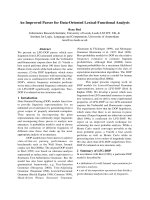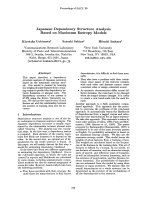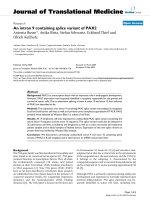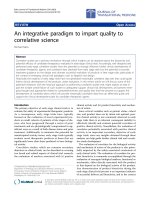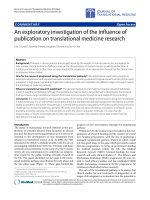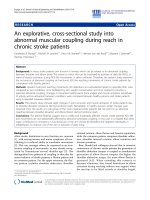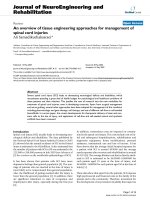Báo cáo hóa học: " An improved EZBC algorithm based on block bit length" doc
Bạn đang xem bản rút gọn của tài liệu. Xem và tải ngay bản đầy đủ của tài liệu tại đây (214.71 KB, 5 trang )
RESEARCH Open Access
An improved EZBC algorithm based on block bit
length
Renlong Wang
1
, Shuangchen Ruan
1*
, Chengxiang Liu
1
, Wenda Wang
2
and Li Zhang
3
Abstract
Embedded ZeroBlock Coding and context modeling (EZBC) algorithm has high compression performance.
However, it consumes large amounts of memory space because an Amplitude Quadtree of wavelet coefficients
and other two link lists would be built during the encoding process. This is one of the big challenges for EZBC to
be used in real time or hardware applications. An impr oved EZBC algorithm based on bit length of coefficients
was brought forward in this article. It uses Bit Length Quadtree to complete the coding process and output the
context for Arithmetic Coder. It can achieve the same compression performance as EZBC and save more than 75%
memory space required in the encoding process. As Bit Length Quadtree can quickly locate the wavelet
coefficients and judge their significance, the improved algorithm can dramatically accelerate the encoding speed.
These improvements are also beneficial for hardware.
PACS: 42.30.Va, 42.30.Wb
Keywords: block bit-length, zeroblock, EZBC, Quadtree, DWT
1. Introduction
At present, the typical embedded wavelet-based image
coding methods includes Embedded Zerotree Wavelet
coder (EZW) [1] proposed by Shapiro, Set Partitioned in
Hierac hical Tree (SPIH T) [2] proposed by Said etc., Set
Partition Embedded block al gorithm (SPECK) [3] pro-
posedbyAsadIslam,EmbeddedBlockCodingwith
Optimal Truncation (EBCOT) [4] used in JPEG2000 [5],
and Embedded ZeroBlock Coding and context modeling
(EZBC) [6] proposed by Shih-Ta Hsiang etc.
Among these algorithms, EZW and SPIHT were based
on the local characteristic in spatial-frequency domain
of wavelet transform. They utilized the similarity of
wavelet coefficients of the same spatial location in differ-
ent subbands. SPECK was based on the characteristic
that the energy concentrated in low-frequency subband
and the insignificant coefficients mainly concentrated in
high-frequency subbands after wavelet tra nsform, it uti-
lized the correlation of insi gnificant coefficients in the
same subband. EBCOT use d the correlation of wavelet
coefficients in the same subband to build the high
efficiency context and adopted the Arithmetic Coder.
EZBC utilized the correlation of coefficients in the same
sub-band and coefficients in different subbands at the
same time and adopted a simple and efficient quadtree
coding structure and context-based bitplane encoding
method [6,7], so it can achieve higher compr ession per-
formance than SPIHT a nd EBCOT. EZBC algorithm is
widely used in digital image compression and scalable
video coding.
However, during the encoding process EZBC built an
Amplitude Quadtree Q
k
[l](i, j) and two link lists: the
insignificant nodes link list LIN and the significant pix-
els link list LS P. Both Amplitude Quadtree Q
k
[l](i, j)
and the link lists consumed a large amounts of memory
space and this was one of the big challenges for the
EZBC to be used in real time or hardware a pplications.
As it has a large amount of operations of link lists such
as adding and deleting nodes during encoding, this
made its coding efficiency decline greatly when good
image quality is required. The algorithm proposed in
reference [8] presented the significance state-table of
Quadtree coefficients to record the significance state
change of all the QuadTree corresponding coefficients
in the coding of Quadtree bitplane, which removed the
LIN and LSP. Some memory was saved but Q
k
[l](i, j)
* Correspondence:
1
Shenzhen Key Laboratory of Laser Engineering, College of Electronic
Science and Technology, Shenzhen University, Shenzhen, 518060, China
Full list of author information is available at the end of the article
Wang et al. EURASIP Journal on Advances in Signal Processing 2011, 2011:84
/>© 2011 Wang et al; licensee Springer. This is an Open Access article distributed under the terms of the Creat ive Commons Attribution
License (http://cre ativecomm ons.org/licenses/by/2.0), which permits unrestricted use, distribution, and reproduction in any medium,
provided the original work is properly cited.
was still adopted in the algorithm. Instead of making
any radical change, it increased the complexity of the
algorithm on the contrary.
In order to overcome these disadvantages, an
improved EZBC algorithm, Bit Length EZBC (BL-EZBC)
based on bit length of coefficients, was put forward in
this article. It used Bit Length Quadtree instead of
Amplitude Quadtree o f wavelet coefficients a nd other
two link lists, so it can save more than 75% memory
space required in the encoding process. As Bit Length
Quadtree can quickly locate the wavelet coefficients,
judge their significance, and avoid a large amount opera-
tions of link lists used in EZBC, this algorithm can
accelerate the encoding speed effectively. The test
results indicates that this algorithm achieves the same
signal to noise ratio as EZBC and gains much higher
encoding speed, saves 75% memory usage than EZBC.
2. Bit Length Quadtree
The bitplane c oding process in BL-EZBC begins with
establishment of the Bit Length Quadtree representa-
tions for the individual subbands. The bit length here
refers to the significant bit length of the absolute value
of quantized wavelet coefficient. The value of the Bit
Length Quadtree node B
k
[l]( i, j) at position (i, j), quad-
tree level l and subband k is defined by
B
k
[l](i, j)=
⎧
⎪
⎪
⎪
⎪
⎪
⎪
⎪
⎪
⎪
⎪
⎪
⎪
⎪
⎪
⎪
⎪
⎨
⎪
⎪
⎪
⎪
⎪
⎪
⎪
⎪
⎪
⎪
⎪
⎪
⎪
⎪
⎪
⎪
⎩
0, l ≡ 0,
c
k
(i, j)
< 1
1+
log
2
(
c
k
(i, j)
)
l ≡ 0,
c
k
(i, j)
≥ 1
max
⎧
⎪
⎪
⎪
⎨
⎪
⎪
⎪
⎩
B
k
[l − 1](2i,2j)
B
k
[l − 1](2i +1,2j)
B
k
[l − 1](2i,2j +1)
B
k
[l − 1](2i +1,2j +1)
⎫
⎪
⎪
⎪
⎬
⎪
⎪
⎪
⎭
l > 0
(1)
where C
k
(i, j) is the quantized subband coefficient at
position (i, j). |x| indicates the absolute value of x;
x
indicates the rounding operation on x. For example, if
x = 3.8
,thenx ≡ 3where“ = “ means assignment
and “≡” indicates the equality test.
Below is an example for B
k
[l](i, j).
If C
k
(i, j) = (± 9), then B
k
[0](i, j) = 4. That i s, the sig -
nificant bit length of ± 9 is equal to 4.
Each bottom quadtree node is assigned to the bit
length of the subband coefficient at the same position.
Thequadtreenodeatthenextlevelisthensettothe
maximum of the four corresponding nodes at the cur-
rent level, as illustrated in Figure 1a. The top quadtree
node is just equal to the maximal bit length of all sub-
band coefficients. Similar to the conventional bitplane
coders, we p rogressively encode subband coefficients
from the MSB toward the LSB. In the Bit Length
Quadtree, a node is significant if the value of the node
B
k
[l](i, j) is great than the index of the bitplane. A sig-
nificant pixel (coefficient) is located by the testing and
splitting operation recursively performed on the signifi-
cant nodes up to the pixel (bottom) level of a quadtree,
as shown in Figure 1b.
Instead of using Amplitude Quadtree Q
k
[l](i, j) and two
link lists in EZBC, the bit length of the Quadtree in BL-
EZBC is built up with the bit length of the absolute value
of the subband coefficients. It corresponds to the index
of the bitplane. It means that Bit Length Quadtree can
quickly locate the wavelet coefficients and judge their sig-
nificance. Thus, it can accelerate the encoding speed
effectively. And the lists of insignificant nodes LIN and
significant nodes LSP required in EZBC are not necessary
in BL-EZBC. What iss more, the usual bit length of wave-
let coefficients is 16. That is, each node of Amplitude
Quadtree Q
k
[l](i, j) uses 16 bit length memory. However,
in BL-EZBC, each node of the Bit Length Quadtree B
k
[l]
(i, j) uses 4 bit length memory. For 4 bit length, the max
value it can represent is 15. It means that the corre-
sponding max absolute value of wavelet coefficients is 2
15
- 1 = 32767. Generally, the absolute value of the wavelet
coefficients is less than 32767. That is, 4 bit length of
each node of Bit Length Quadtree can represent the bit
length of wavelet coefficients. This saves a large amount
of memory space required in the coding process.
3. The coding process of BL-EZBC
First, define parameters below,
• C
k
(i, j): the quantized wavelet coefficient of sub-
band k at position (i, j).
6LJQLFDQW1RGH
4XDGWUHH
OHYHO
6LJQLFDQW1RGH
,QVLJQLFDQW1RG
H
&RGHVWUHP
(
a
)
4XDGWUHH%XLOGXS
(
E
)
4XDGWUHH6SOLWWLQJ
4XDGWUHH
OHYHO
4XDGWUHH
OHYHO
3L[HOOHYHO
Figure 1 Illustration of quadtree build up and decomposition.
(a) Quadtree build up and (b) Quadtree splitting.
Wang et al. EURASIP Journal on Advances in Signal Processing 2011, 2011:84
/>Page 2 of 5
• B
k
[l](i, j): Bit Length Quadtree B representation for
the bit length of coefficients from the same subband
with node of B
k
[l](i, j) corresponding to a quadtree
node at position (i, j), Suband k, and level l. Its value
is defined by (1).
• D
k
: depth of the quadtree of the subband k.
• D
max
: the maximum quadtree depth among all
subbands.
• K: total number of subbands.
• X
k
: Horizontal offset of the subband k referring to
the original image, left-to-right as a positive
direction.
• Y
k
: Vertical offset of the subband k referring to the
original image, top-to-down as a positive direction.
• CodeBL(k, l ): Function for coding the insignificant
node of level l in Bit Length Quadtree of su bband k.
Its parent node should be signficant in the last bit-
plane if it exists.
• CodeDescendant(k, l, i, j): function for processing
all the descendent nodes of B
k
[l ](i, j)afteritjust
tested significant against the current threshold.
• CodeLSP(k): function for refinement of the coeffi-
cients of subband k.
The coding process,
Initialization,
n =max
(k)
{B
k
[D
k
− 1](0, 0)};
Coding the highest bitplane,
for k =0:K-1, Code BL(k, D
k
-1);
n–;
Coding the remaining bitplanes.
for (;n >0;n–){
for l =0:D
max
-1
for k =0:K-1, Code BL(k, l);
for k =0:K-1, Code LSP(k);
}
Below are the functions in pseudocode,
CodeBL (k, l)
{
• if (l <D
k
-1)
* fo r all (i, j)inquadtreelevell+1, subband k.
That is, all the nodes in level l+1 of Bit Length
Quadtree of subband k
⋆ if (B
k
[l+1](i, j)>n), CodeDescendant (k, l+1,
i, j);
• else if (l ≡ D
k
-1)
* if (B
k
[l](0, 0) <n), output 0;
* else if (B
k
[l](0, 0) ≡ n){
output 1;
⋆ if (l ≡ 0)
-output the sign of C
k
(0+X
k
,0+Y
k
);
⋆ else
- CodeDescendant (k, l, 0, 0);
}
}
CodeDescendant (k, l, i, j)
{
• for (x, y)Î{(2i,2j), (2i,2j+1), (2i+1, 2j), (2i+1, 2j
+1)}. That is, the four child nodes in level l- 1 that
mapping to the node (i, j) in level l, subband k
* if (B
k
[l-1](x, y)<n), output 0;
* else if (B
k
[l-1](x, y) ≡ n){
output 1;
⋆ if (l ≡ 1)
-output the sign of C
k
(x+X
k
, y+Y
k
);
⋆ else
-CodeDescendant (k, l-1, x, y);
}
}
CodeLSP (k)
{
• for all (i, j) in quadtree level 0, subband k.Thatis,
all the nodes in level 0 of Bit Length Quadtree of
subband k, scanning first in row then column.
* if (B
k
[0](i, j)>n), output the value of |C
k
(I + X
k
, j +
Y
k
) | in bitplane n.
}
4. Experimental results and analysis
The improved algorithm BL-EZBC and the original
EZBC were verified and compared in Pentium(R) D
CPU 2.80 GHz computer with 512 × 512 × 8 bits Stan-
dard grayscale images of Lena, Goldhill and Barbara. 9/7
Wavelet filters boundary symmetrical extension was
used. The context model was the same as which used in
EZBC algorithm, the algorithm data in reference [8]
were quoted here. Table 1 listed out the PSNR compari-
son. Table 2 shows the memory usage comparison dur-
ing coding. Table 3 shows the coding time comparison
with different thresholds of BL-EZBC and EZBC.
From Table 1, the same PSNR was achieved by using
BL-EZBC, algorithm in referenc e [8] a nd EZBC. How -
ever, EZBC used Amplitude Quadtree Q
k
[l](i, j) and two
link lists (LIN and LSP) to finish the coding process and
utilized the significance of the neighbor nodes and the
node in parent subband to construct the context, so a
largeamountofmemorywasrequiredtostoreAmpli-
tude Quadtree Q
k
[ l](i, j) and two link lists. Therefore,
more memory was required for more com plex image
and higher coding bit rate. These increased the
Wang et al. EURASIP Journal on Advances in Signal Processing 2011, 2011:84
/>Page 3 of 5
complexity of the hardware. Although linked lists LIN
and LSP were removed from the algorithm in reference
[8], Amplitude Quadtree Q
k
[l](i, j) and significance
state-table of Quadtree coefficients were st ill adopted,
which also occupied a lot of memory and increased the
algorithm complexity. Bit Length Quadtree was pre-
sented to replace the Amplitude Quadtree in the
improved algorithm, which was used to complete the
coding process and construct the context, so the me m-
ory usage was greatly reduced during the coding. As
shown in Table 2, by using the improved algorithm BL-
EZBC, more than 75% memory was saved c ompared to
the original EZBC algorithm. Therefore, the memory
usage was significantly reduced.
As EZBC used a large amount of operations of link
lists such as adding and deleting nodes during encod-
ing, this made its coding efficiency decline greatly
when good image quality was required. Instead of
using Amplitude Quadtree Q
k
[l](i, j) and two link lists
in EZBC, the bit length of the Quadtree in BL-EZBC is
built up with the bit length of the absolute value of
the subband coefficients. It corresponds to the index
of the bitplane. It means that Bit Length Quadtree can
quickly locate the wavelet coefficients, judge their sig-
nificance. Thus, it can accelerate the encoding speed
effectively. As shown in Table 3, if the threshold less
than 32, the coding time of BL-EZBC was significantly
less than EZBC. If the threshold is great than or equal
to 32, the coding time of BL-EZBC was less than
EZBC too. However, it was not so obvious. A larger
threshold means less bitplanes would be scanned, the
size of link lists was smaller, and the operations of link
lists were also fewer. As the larger threshold means
the worse image quality, in most situations in order to
achieve better image quality the threshold was not so
large. When good image quality was required, the cod-
ing speed of BL-EZBC is significantly faster than
EZBC.
5. Conclusion
An improved algorithm BL-EZBC based on EZBC was
proposed in this article. A new model Bit Length Quad-
tree was used to complete the coding process and con-
struct the context. It can achieve the same compression
performance as EZBC but the memory usage was greatly
reduced during the coding process. Bit Length Quadtree
can quickly locate the wavelet coefficients, judge their
significance, and avoid a large amount operations of link
lists used in EZBC. Thus, it can accelerate the encoding
speed effectively. These improvements are also beneficial
for the hardware.
Abbreviations
EBCOT: Embedded Block Coding with Optimal Truncation; EZBC: Embedded
ZeroBlock Coding and context modeling; EZW: Embedded Zerotree Wavelet
coder; SPECK: Set Partition Embedded block algorithm; SPIHT: Set Partitioned
in Hierachical Tree.
Acknowledgements
This work was supported in part by the Shenzhen Double Hundred Person
Project and the Shenzhen University Dr start-up fund research (000201) of
China.
Author details
1
Shenzhen Key Laboratory of Laser Engineering, College of Electronic
Science and Technology, Shenzhen University, Shenzhen, 518060, China
2
College of Automation, Harbin Engineering University, Harbin, 15001, China
3
College of Information Engineering, Shenzhen University, Shenzhen, 518060,
China
Competing interests
The authors declare that they have no competing interests.
Table 1 PSNR(dB) comparison.
Image Rate (bpp) Ref [8] EZBC BL-EZBC
Lena 1.0 40.58 40.63 40.63
0.5 37.44 37.49 37.49
0.25 34.32 34.41 34.42
Goldhill 1.0 36.78 36.93 36.93
0.5 33.37 33.45 33.45
0.25 30.71 30.77 30.76
Barbara 1.0 37.17 37.35 37.37
0.5 32.08 32.27 32.28
0.25 28.20 28.37 28.39
Table 2 Memory usage comparison (Bytes).
Image Rate (bpp) Ref [8] EZBC BL-EZBC
Lena 1.0 726K 844K 171K
0.5 726K 765K 171K
0.25 726K 730K 171K
Goldhill 1.0 726K 853K 171K
0.5 726K 767K 171K
0.25 726K 726K 171K
Barbara 1.0 726K 861K 171K
0.5 726K 773K 171K
0.25 726K 736K 171K
Table 3 Coding time comparison with different threshold
with BL-EZBC and EZBC (ms).
Threshold 1 2 4 8 16 32 64
Lena
BL-EZBC 156 109 63 47 31 20 15
EZBC 406 312 187 93 46 31 20
Goldhill
BL-EZBC 172 125 94 62 46 26 16
EZBC 453 375 265 156 78 32 21
Barbara
BL-EZBC 171 125 93 78 47 31 20
EZBC 422 344 234 140 94 47 31
Wang et al. EURASIP Journal on Advances in Signal Processing 2011, 2011:84
/>Page 4 of 5
Received: 9 March 2011 Accepted: 10 October 2011
Published: 10 October 2011
References
1. JM Shapiro, Embedded image coding using zerotrees of wavelet
coefficients. IEEE Trans Signal Process. 41(12), 3445–3462 (1993).
doi:10.1109/78.258085
2. A Said, WA Pearlman, A new, fast, and efficient image codec based on set
partitioning in hierarchical trees. IEEE Trans Circuits Syst Video Technol. 6(3),
243–250 (1996). doi:10.1109/76.499834
3. A Islam, WA Pearlman, An embedded and efficient low-complexity
hierarchical image coder, in Visual Communication and Image Processing ‘99,
vol. 3653. (San Jose, California, SPIE, 1999), pp. 294–305
4. D Taubman, High performance scalable image compression with EBCOT.
IEEE Trans Image Process. 9(7), 1158–1170 (2000). doi:10.1109/83.847830
5. M Rabbani, R Joshi, An overview of the JPEG2000 still image compression
standard. Signal Process Image Commun. 17(1), 3–48 (2002). doi:10.1016/
S0923-5965(01)00024-8
6. S-T Hsiang, Highly Scalable Subband/Wavelet Image and Video Coding,
(Rensselaer Polytechnic Institute, New York, 2002)
7. ST Hsiang, JW Woods, Embedded image coding using zeroblocks of
subband/wavelet coefficients and context modeling, in IEEE ISCAS2000,
(IEEE, Geneva, Switzerland, 2000), pp. 662–665
8. W Du, J Sun, M Sima, Improved EZBC algorithm with low complexity. IEICE
Electron Express. 1(15), 447–452 (2004). doi:10.1587/elex.1.447
doi:10.1186/1687-6180-2011-84
Cite this article as: Wang et al.: An improved EZBC algorithm based on
block bit length. EURASIP Journal on Advances in Signal Processing 2011
2011:84.
Submit your manuscript to a
journal and benefi t from:
7 Convenient online submission
7 Rigorous peer review
7 Immediate publication on acceptance
7 Open access: articles freely available online
7 High visibility within the fi eld
7 Retaining the copyright to your article
Submit your next manuscript at 7 springeropen.com
Wang et al. EURASIP Journal on Advances in Signal Processing 2011, 2011:84
/>Page 5 of 5
